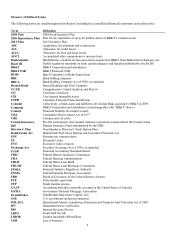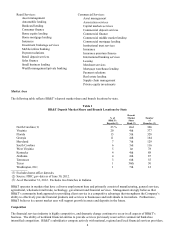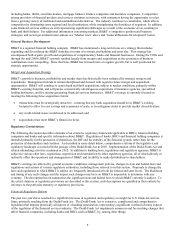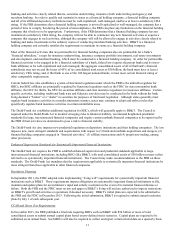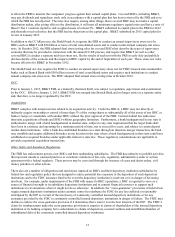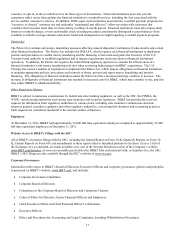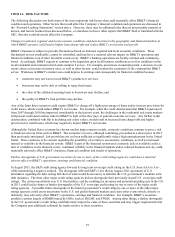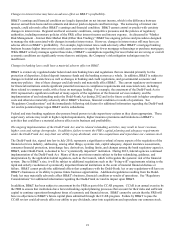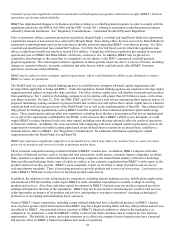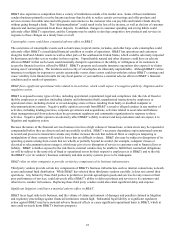BB&T 2012 Annual Report Download - page 36
Download and view the complete annual report
Please find page 36 of the 2012 BB&T annual report below. You can navigate through the pages in the report by either clicking on the pages listed below, or by using the keyword search tool below to find specific information within the annual report.
14
As part of the Dodd-Frank Act, provisions were added that require federal banking agencies to develop capital requirements,
which are discussed in more detail below. The effect of these capital rules will disallow trust preferred securities from
inclusion as Tier 1 capital at the holding company level for entities with greater than $15 billion in assets with a three-year
phase-in period beginning on January 1, 2013.
Information related to certain capital ratios is shown in the following table.
Table 2
Capital Adequacy Ratios
December 31, 2012
Regulatory
Minimums Branch
Regulatory to be Well- Branch BB&T Bank
Minimums Capitalized BB&T Bank FSB Proforma (1)
Risk-based capital ratios:
Tier 1 common capital N/A N/A 9.3 % 9.3 % 23.6 % 9.7 %
Tier 1 capital 4.0 6.0 11.0 11.6 23.6 12.0
Total risk-based capital 8.0 10.0 13.9 13.4 24.9 13.8
Tier 1 leverage capital ratio 3.0 5.0 8.2 8.6 22.8 8.9
(1) Represents the proforma combined capital ratios of Branch Bank and BB&T FSB as if the two entities had been merged
on December 31, 2012.
The federal banking agencies, including the FRB and the FDIC, are required to take “prompt corrective action” in respect of
depository institutions and their BHCs that do not meet minimum capital requirements. The law establishes five capital
categories for insured depository institutions for this purpose: “well-capitalized,” “adequately capitalized,”
“undercapitalized,” “significantly undercapitalized” and “critically undercapitalized.” To be considered “well-capitalized”
under these standards, an institution must maintain a total risk-based capital ratio of 10% or greater; a Tier 1 risk-based
capital ratio of 6% or greater; a leverage capital ratio of 5% or greater; and must not be subject to any order or written
directive to meet and maintain a specific capital level for any capital measure.
Federal law also requires the bank regulatory agencies to implement systems for “prompt corrective action” for institutions
that fail to meet minimum capital requirements within the five capital categories, with progressively more severe restrictions
on operations, management and capital distributions according to the category in which an institution is placed. Failure to
meet capital requirements also may cause an institution to be directed to raise additional capital. Federal law also mandates
that the agencies adopt safety and soundness standards generally relating to operations and management, asset quality and
executive compensation, and authorizes administrative action against an institution that fails to meet such standards.
In addition to the “prompt corrective action” directives, failure to meet capital guidelines may subject a banking organization
to a variety of other enforcement remedies, including additional substantial restrictions on its operations and activities,
termination of deposit insurance by the FDIC and, under certain conditions, the appointment of a conservator or receiver.
Basel III
In 2010, the Group of Governors and Heads of Supervisors of the BCBS, the oversight body of the Basel Committee,
published Basel III. Under these standards, when fully phased in, banking institutions will be required to maintain
heightened Tier 1 common equity, Tier 1 capital and total capital ratios, as well as maintaining a “capital conservation
buffer.” As proposed, Basel III provides for the Tier 1 common equity and Tier 1 capital ratio requirements to be phased in
incrementally between January 1, 2013 and January 1, 2015; the deductions from common equity made in calculating Tier 1
common equity (for example, for mortgage servicing assets, deferred tax assets and investments in unconsolidated financial
institutions) to be phased in incrementally over a four-year period commencing on January 1, 2014; and the capital
conservation buffer to be phased in incrementally between January 1, 2016 and January 1, 2019. The BCBS also announced
that a “countercyclical buffer” of 0% to 2.5% of common equity or other fully loss-absorbing capital “will be implemented
according to national circumstances” as an “extension” of the conservation buffer. The final package of Basel III reforms
were approved by the G20 leaders in November 2010 and are subject to individual adoption by member nations, including
the United States.
U.S. Implementation of Basel III
In June 2012, the FRB, FDIC, and OCC issued a joint release announcing three separate NPRs seeking comment on proposed
rules that would revise and replace their current capital rules in a manner consistent with relevant provisions of the Dodd-


